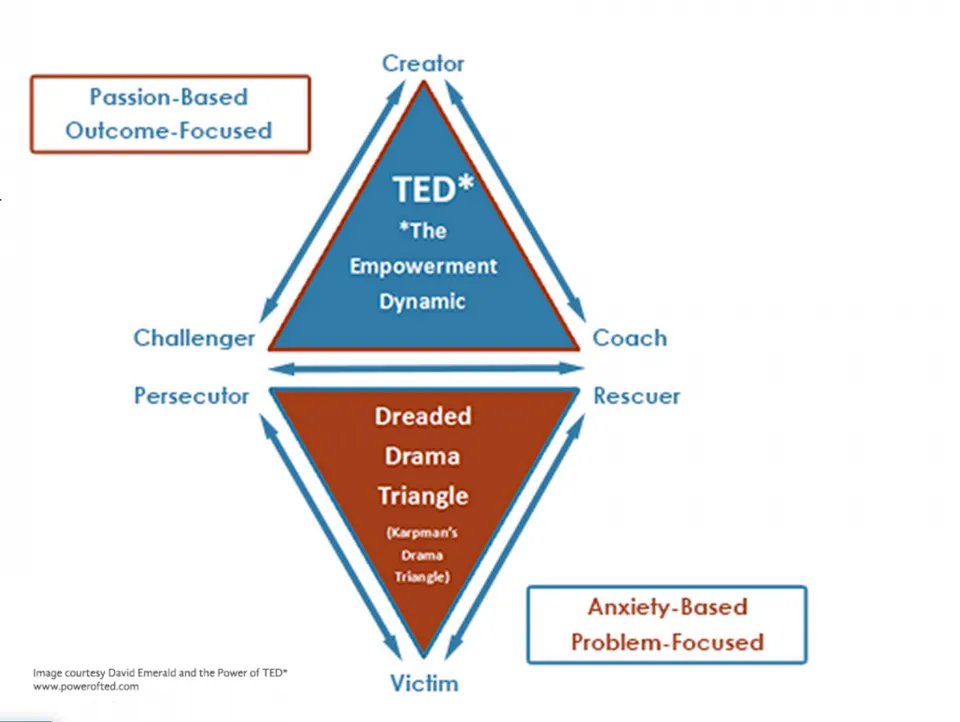If you’re stuck taking on the roles of victim, rescuer, and persecutor,
you can never move forward.
The Drama Triangle was first described by Stephen Karpman in the 1960s. In 2016, David Emerald illustrated the theory in parable form in his book The Power of TED.
“It is a model of dysfunctional social interactions and illustrates a power game that involves three roles: Victim, Rescuer, and Persecutor, each role represents a common and ineffective response to conflict.” -leadershiptribe.com
These roles are often played out between parents and children, partners, friends, and coworkers.
The victim is the role of feeling sorry for oneself. A “poor me” mentality. They have usually experienced loss or defeat in some hopes and dreams. Note, this is different from someone who has been victimized by a situation. The victim lives in a state of helplessness, feeling disempowered and trapped by the circumstances of their life. They don’t see a way to take action to make their life different, instead feeling like life happens to them. Victims rely on rescuers to help them out of this experience.
The rescuer tries to help the victim by giving them positive feedback, support and short-term solutions. They have a “let me help you”or “poor you” mentality. The rescuer often has a fear of abandonment wound or a loss of purpose. They can end up feeling dissatisfied when the victim becomes endlessly reliant on them. Rescuers tend to put their own needs aside due to always helping the victim avoid their own pain, creating a sense of fatigue for the rescuer.
The persecutor is the one who makes the victim feel bad about themselves. They have an “it’s all your fault” mentality. They might blame or criticize them, make fun of them, or even threaten them. A persecutor is rigid and usually has a fear of losing control or fear of being or re-becoming a victim themselves.
We can all identify times when we have played any of these roles. Once on the dreaded drama triangle, we can shift roles, but this means the other parties involved also shift their role. Without awareness, we can get stuck on the triangle long-term.
How do I step off the dreaded drama triangle?
“You’re not a human being seeking a spiritual experience; you’re a spiritual being having a human experience…All humans beings are spiritual beings, but most sleepwalk through their days. They are unaware…that they have a greater capacity for choice than they know.” -TED
Once we are aware of the roles, instead of being reactive, we can choose our response to circumstances.
“Everything can be taken from a man but one thing: the last of the human freedoms — to choose one’s attitude in any given set of circumstances, to choose one’s own way.” -Viktor Frankl
We need to make a conscious choice to shift to the Empowerment Triangle. Shift happens.

Making the Shift From Drama to Empowerment
In The Power of TED, David Emerald suggests all roles ask themselves these three questions: 1. WHERE ARE YOU PLACING YOUR FOCUS? Is it triggering anxiety or creating outcomes that matter to you?
2. HOW ARE YOU RELATING? To the situation, the person and yourself? Is it in a way that perpetuates drama or empowers and elevates all involved?
WHAT ACTIONS ARE YOU TAKING? Are you reacting or creating solutions that matter?
Instead of Victim, shift to Creator. Creators focus on outcomes instead of problems. They ask themselves what they really want and not what they don’t want. They ask themselves how they want to show up in a situation. Creators choose compassion, for themselves and others, as a first line of defense.
Rescuers choose to become Coaches. They shift to seeing people not as powerless or dependent, but assume others are capable of choosing their own path and capable of navigating it. They can offer suggestions without investment in whether or not others take them. Coaches remain curious, asking questions to support more than giving directives.
Persecutors choose to become Challengers. Emerald suggests forgiveness of self and others is essential for this shift. Letting go of what never was and looking more to how experiences have created lessons and growth and helping others to do the same.
Challengers inspire others to reach for the highest good of all involved. They are “truth-tellers”. They notice if someone is getting defensive in response to them and can shift back to allowing space for others to be responsible for their own choices and to step into their own power.
Making these shifts takes time. We need to take some time to reflect on when we have shown up in each role and with whom. What were we trying to control or manipulate? What did we really want as an outcome? How could we have chosen different responses and what would that have looked like?
Next time you have a conflict try to pause and see it from this dynamic. Try the suggested responses above and notice what happens. Remember, often the only control we have is in choosing how we respond to any given situation.
If you need the support of a life coach or therapist, I’m here to help with this. Reach out for a free consult call at www.jhoffmantherapy.com/contact-me

